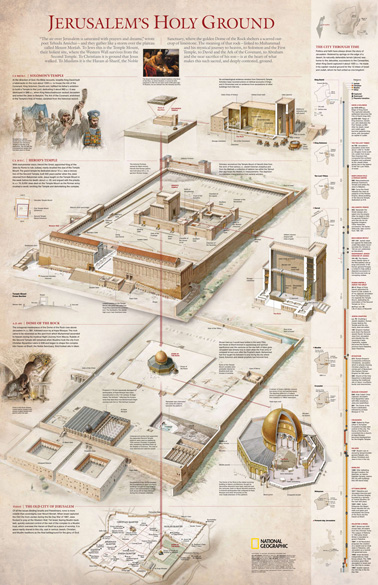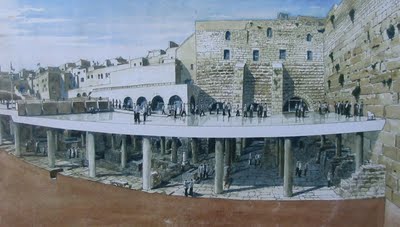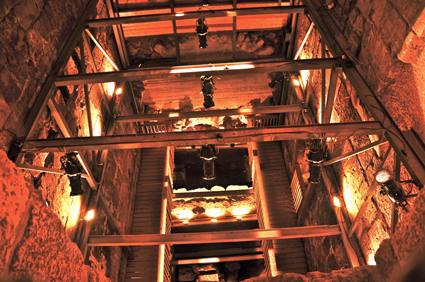On Thursday, December 24, 2009 a conference will be held dealing with new studies on Jerusalem at the Ingeborg Rennert Center, Martin (Szusz) Department of Land of Israel Studies and Archaeology, The Faculty of Jewish Studies at the Bar-Ilan University in Israel. The conference will be held in Hebrew, but the proceedings with English abstracts will be available at the conference. If you understand Hebrew and are lucky enough to be in Israel at that time, here is the programme:
8:20 gathering
8:45 opening remarks:
Prof. Joshua Schwartz, Director of the Ingeborg Rennert Center for Jerusalem Studies
Prof. Avraham Faust & Dr. Eyal Baruch, conference organizers
Session 1 – 9:00-10:55
Chair: Eyal Baruch
09:00 Ronny Reich & Eli Shukron- Channel II in the City of David, Jerusalem: Technical Details, Date and Function
09:20 Avraham Faust- King David’s Palace, a Hellenistic Structure or a Jebusite Fort: A Reexamination of the Large Stone Structure Unearthed by Eilat Mazar in the City of David
09:40 Moshe Garsiel- The Book of Samuel: Compilation Stages and Historical Value for Describing David’s Kingdom and His Capital in Jerusalem
10:05 Ehud Nezer- An opus reticulatum Structure, West of the Old City, Jerusalem
10:25 Ram Bouchnick, Omri Larnow, Guy Bar-Oz & Ronny Reich- Jerusalem Fish Menu from the Late Second Temple Period
10:45 Discussion
10:55 Break
Session 2 – 11:20-13:10
Chair: Joshua Schwartz
11:20 Michael Ben-Ari- Simchat Beit Sho’eva – The Origins of the Custom.
11:40 Varda Sussman- Shaving/paring of Herodian Oil Lamps
12:00 Ze’ev H. Erlich (Jabo) – What is the ‘Kotel ha-Katan?’
12:20 Amos Kloner- The Damascus Gate
12:40 Yoav Farhi & Oded Lifshitz- A Unique Bulla from the Ramat Rahel Excavations Bearing the Name of Hadrian
13:00 Discussion
13:10 Lunch Break
Session 3 – 14:20-16:30
Chair: Josef Drory
14:20 Yehoshua Peleg- Were the Temple Mount Gates Reconstructed in the Second Century CE?
14:40 Gabriel Barkay and Zachi Zweig- A Roman Period Centaur Relief from the Temple Mount
15:00 Perez Reuven- A Decorated Beam from the Roman Period in the Temple Mount
15:20 Bat-Sheva Garsiel- The Status of Jerusalem in Early Islamic Theological Writings
15:40 Michael Ehrlich- The Southern Quarters of Jerusalem during the Medieval Period: A Multi-Periodical Overview
16:00 Oded Shay- The Contribution Made by the Jerusalem-based Monk Father Antonin, to Jewish Studies and to the Research of the Material Culture of Palestine in the Final Years of the Ottoman period
16:20 Discussion
16:30 Break
Session 4 – 17:00-18:30
Chair: Boaz Zissu
17:00 Amos Frumkin & Boaz Lengford- The Research of a Karstic Cave Used for Refuge in the Jerusalem Hills
17:20 Boaz Zissu & Roi Porat- A Hoard of Coins and Other Finds from the Bar-Kokhba Period, Recently Discovered in a Refuge Cave in the Jerusalem Hills
17:40 Guy Stiebel- “On the Edge” – Military Equipment from a Refuge Cave in the Jerusalem Hills
18:00 Hanan Eshel- New Discoveries from a Refuge Cave in the Jerusalem Hills, and their Contribution to the Study of the Bar-Kokhba War
18:20 Discussion
Source: Joe Lauer










